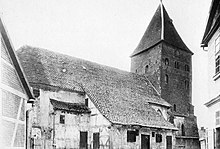St. John's Church (Dahlenburg)

The Evangelical Lutheran St. John's Church is in Dahlenburg in the Lower Saxony district of Lüneburg .
location
The free-standing St. John's Church stands on a small green area with scattered trees in the historic center of Dahlenburg. The city's market square is to the east.
history
The oldest documentary evidence of the St. John's Church dates back to 1302. The direct predecessor of today's building was a brick church with a granite foundation.
The current church building was built between 1903 and 1905 according to the design by the architect Wilhelm Matthies from Bardowick . The field stone masonry of the previous church was partially integrated into the new building. In 1967 renovations followed, including a new hall built into the north gallery.
architecture
The St. John's Church is a neo-Gothic brick building . This is divided into the west tower , the two-aisled nave , a polygonal choir closure , a sacristy on the south side and an entrance building connected to the north of the nave, which is flanked by two small towers. The roofs of the church are covered with red roof tiles.
The two-aisled interior is divided into three unequal bays with ribbed vaults . The church originally had a west and side gallery. The side gallery is no longer available today due to the new construction of the entrance area. The organ is on the west gallery . The church offers a total of 750 people.
Furnishing
The altarpiece dates from the 14th or 15th century. It is a late Gothic three-winged carved altar. The altarpiece shows the crucifixion of Jesus and figures of saints. The predella shows paintings by Friedrich Koch from 1905.
The pulpit dates from 1604. The pulpit is richly decorated and is carried by an almost life-size female figure.
The first organ was delivered by the organ builder Stein from Lüneburg in 1763. This instrument was removed in 1903 and replaced with a new one in 1905. Due to major damage, it had to be replaced by a new organ with 16 registers in 1974 . The prospectus of the old organ was taken over.
Peal
When the church was completed in 1905, the two bells from the previous building were taken over and two new ones were added. The older of the two bells was already a thousand years old at this point. The new bells were melted down during the First World War in 1917 and initially replaced in 1925. In 1943, during the Second World War, the three largest bells, including the oldest, had to be melted down. In 1952 two new cast steel bells were cast.
Web links
- Internet presence of the St. Johannes parish in Dahlenburg
Individual evidence
- ↑ a b c d story. In: kirche-dahlenburg.de. Retrieved June 23, 2020 .
- ^ Hector Wilhelm Heinrich Mithoff: Fürstenthum Lüneburg . In: Art monuments and antiquities in Hanover . tape 4 . Helwing, Hannover 1877, p. 115 .
- ↑ a b c d Gerd Weiß: District of Lüneburg . In: Hans-Herbert Möller (Hrsg.): Monument topography Federal Republic of Germany. Architectural monuments in Lower Saxony . Vieweg, Braunschweig 1981, ISBN 978-3-528-06201-9 , pp. 113 .
- ↑ a b Carolin George, Berit Neß: God's houses: From the tower made of field stones to the glass altar . Ed .: Ev.-luth. Church district Lüneburg. Evangelical Lutheran Church District Lüneburg, Lüneburg 2017, ISBN 978-3-00-054672-3 , p. 50 .
- ^ A b Carolin George, Berit Neß: Church leader for the Hanseatic city and the district of Lüneburg . Ed .: Lüneburg Tourist Office. Lüneburg 2009, p. 69 .
- ↑ Church news. In: https://web.archive.org . Retrieved June 23, 2020 .
Coordinates: 53 ° 11 ′ 11.7 " N , 10 ° 44 ′ 32" E

